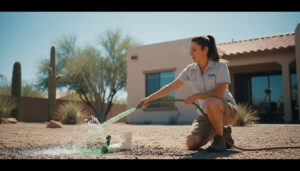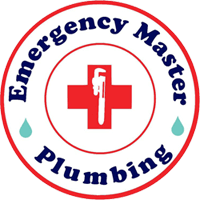

Arizona’s desert climate brings unique challenges to home plumbing systems, from scorching summer heat to occasional winter freezes and monsoon rains. Regular seasonal maintenance helps prevent costly repairs like burst pipes or slab leaks, while improving water efficiency in a drought-prone state. This guide provides a comprehensive, problem-solving approach to seasonal plumbing care tailored for Arizona homeowners, ensuring your system stays reliable year-round.
By following these expert-recommended steps, you can address common issues such as hard water buildup and temperature-induced expansions before they escalate. With Arizona’s extreme temperature swings, proactive checks can extend pipe life and reduce water waste by up to 70%. Let’s dive into season-specific strategies to keep your plumbing in top shape.
Spring Plumbing Maintenance in Arizona
Spring in Arizona signals warmer days after mild winters, but it also uncovers winter-related damage like hidden leaks from rare freezes. Start by inspecting all visible pipes for cracks or corrosion, especially in garages or attics where cold snaps might have caused stress. Addressing these early prevents water damage to foundations, a common issue in the state’s expansive soils.
One key problem is low water pressure from sediment accumulation during cooler months. Test your faucets by running water at full force; if pressure feels weak, clean aerators or check the pressure regulator to restore flow and efficiency. For irrigation systems vital in Arizona’s dry spring, examine sprinkler heads and drip lines for leaks, which can waste precious water resources. Repair or replace damaged components to avoid uneven yard watering and higher bills.

Flushing your water heater removes built-up minerals from Arizona’s hard water, improving energy efficiency before summer demand peaks. Turn off the power, attach a hose to the drain valve, and flush until water runs clear—this simple task can boost performance by 20-30%. Also, clear indoor drains with a mixture of baking soda and vinegar to dissolve grease from winter cooking, preventing clogs that block flow.
Outdoor spigots often suffer from winter exposure, so inspect hose bibs for drips and insulate them with foam covers. If you notice persistent leaks, tighten connections or replace washers to stop water loss, which averages 10,000 gallons annually per household from minor issues. Finally, test your sump pump if your home has one, as spring rains can overwhelm drainage in low-lying areas. A functioning pump averts basement flooding, protecting your plumbing infrastructure.
These steps solve spring vulnerabilities, ensuring a smooth transition to hotter months without surprises.
Summer Plumbing Maintenance in Arizona
Arizona summers bring intense heat exceeding 100°F, causing pipes to expand and soil to shift, which can lead to slab leaks under foundations. Monitor for warm spots on floors or unexplained spikes in water bills, as these signal underground issues common in the state’s clay-heavy soils. Early detection via a professional camera inspection prevents extensive repairs costing thousands.
Evaporative coolers and AC units strain plumbing with condensate lines that clog from mineral deposits in hard water. Flush these lines monthly using a vinegar solution to dissolve buildup, avoiding backups that flood interiors. For pools popular in Arizona, inspect pumps and filters for leaks, as heat accelerates wear on seals. Tighten fittings and lubricate valves to maintain circulation and prevent water loss.
Tree roots seek moisture in dry summers, invading sewer lines and causing backups. Schedule a rooter service if you experience slow drains, as preventive hydro-jetting clears blockages without harsh chemicals. Indoors, check toilets for silent leaks by adding food coloring to the tank—if it seeps into the bowl within 15 minutes, replace the flapper to save up to 200 gallons daily.
Irrigation systems demand attention amid water restrictions; calibrate timers and fix emitters to optimize usage without overwatering. High heat also stresses water heaters, so verify the temperature setting at 120°F to balance hot water needs and energy costs. If expansion noises occur, install a tank to absorb pressure from heating cycles.
By tackling these heat-related problems, summer maintenance safeguards your plumbing against Arizona’s arid extremes.
Fall Plumbing Maintenance in Arizona
Fall prepares Arizona homes for cooling nights and monsoon remnants, focusing on drainage and insulation to handle variable weather. Clear gutters and yard drains of leaves and debris, as blockages lead to overflow and foundation erosion during late rains. Use a leaf blower or plumber’s snake for thorough cleaning, preventing water intrusion into pipes.
Monsoons increase flood risk, so test and maintain sump pumps by pouring water into the basin to ensure automatic activation. Replace batteries in backup systems for reliability during power outages. Insulate exposed pipes in unheated spaces with foam sleeves, as dropping temperatures can cause condensation and drips.
Hard water scaling clogs drains after summer use, so clean garbage disposals with ice cubes and lemon peels to sharpen blades and deodorize. For sewer lines, inspect for root intrusion via a camera scope, especially near mature trees seeking fall moisture. Enzymatic cleaners break down organic matter safely, avoiding pipe corrosion from chemical alternatives.
Service your water heater annually in fall by checking the anode rod for corrosion, which protects the tank from rust. Drain a few gallons to remove sediment, enhancing efficiency before winter. Also, seal gaps around pipes entering walls with caulk to block drafts and pests.
These proactive measures resolve fall-specific risks, setting up your system for cooler months.
Winter Plumbing Maintenance in Arizona
Though mild, Arizona winters feature freezing nights below 32°F, particularly in higher elevations, risking pipe bursts if unprepared. On cold evenings, let faucets drip a trickle to keep water moving and prevent freezing in exposed lines. Disconnect and drain garden hoses, storing them indoors to avoid pressure buildup.
Insulate pipes in attics, crawl spaces, and exterior walls using heat tape or sleeves, focusing on north-facing areas prone to chill. Seal foundation cracks and window drafts with weatherstripping to maintain indoor warmth and reduce pipe stress. Know your main shut-off valve location and test it—shut off water briefly to confirm operation in emergencies.
Hard water minerals thicken in cooler temperatures, so monitor pressure and descale fixtures with citric acid solutions. For water heaters, set to energy-saving mode and inspect for leaks, as demand shifts to heating. If your home uses well water, test for quality to catch winter contaminants from runoff.
Rare freezes amplify slab leak risks, so watch for damp spots and address promptly with insulation upgrades. These steps mitigate Arizona’s subtle winter threats effectively.
Why Seasonal Plumbing Maintenance Matters in Arizona
Arizona’s climate—hot days, dry air, and hard water—accelerates wear on plumbing, leading to issues like scaling and leaks if ignored. Year-round checks conserve water, vital amid droughts, and comply with local efficiency standards. Professional inspections catch hidden problems, saving on repairs that average $1,500 for bursts.
Incorporate low-flow fixtures to combat hard water effects, reducing buildup while meeting usage goals. Track bills monthly for anomalies, as a 10% rise signals leaks. Educate household members on basics to prevent misuse.
Common Arizona Plumbing Problems and Solutions
Hard water causes calcification, narrowing pipes—flush systems quarterly with descalers. Slab leaks from heat shifts require leak detection tech for pinpoint fixes. Monsoon clogs demand cleanouts; install backflow preventers. Frozen pipe bursts, though rare, need immediate thawing with warm towels, not torches. Sewer root intrusion uses mechanical cutting over chemicals.
For emergencies, shut off water and call experts to avoid DIY damage.
In summary, seasonal maintenance empowers Arizona homeowners to solve plumbing woes proactively, ensuring safety and savings.
For professional seasonal plumbing services in Arizona, contact Emergency Master Plumbing & Air at 623-584-4706. Our team specializes in tailored inspections and repairs to keep your system running smoothly year-round.
